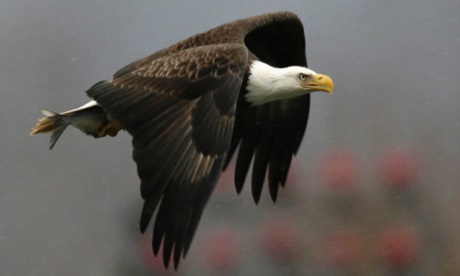The U.S. Fish and Wildlife Service (USFWS) made changes to its eagle conservation program, and the Associated Press (AP) and Fox News misrepresented what it means, starting right in their headlines.
And no, eagle populations have never been at risk from wind power and are not now.
From the AP: Final wind turbines rule permits thousands of eagle deaths
Reality: To start with, this rule in not specific to the wind industry—it applies to any person or industry who might unintentionally harm an eagle by an otherwise lawful activity, after first taking every step possible to avoid and minimize the threat.
Over 400 permits have been issued under this program since 2009, only three for wind companies. Other activities and industries that could potentially impact eagles that are eligible for permits are oil and gas development operations, farming and ranching operations, mining companies, utilities, and the transportation sector, among others.
From Fox News: New rules protect green energy wind companies from federal fines even if thousands of bald eagles are killed every year.
Reality: Contrary to some reporting, impacts on bald eagles by wind turbines are vanishingly rare, with only a handful of recorded impacts in the four-decade history of American wind power.
Further, USFWS’s eagle conservation program does not provide permits to companies allowing them to kill any significant number of bald eagles each year.
The figure 4,200 represents USFWS’s scientific estimation of how many bald eagles could theoretically be harmed over and above current mortality rates, both through natural and all human-related causes, without the species declining due to reproduction rates.
The total number of eagle deaths the Service expects to authorize annually from all new sources will never come close to reaching thousands. As the USFWS has stated, this figure is in no way representative of the losses it expects, or would ever allow, under the eagle conservation program—it is a minuscule fraction of that number.
The USFWS explains this in the final eagle rule, beginning on page 143, in response to a similar mischaracterization.
Moreover, any entities that impact eagles without a permit could face a penalty. It is a gross mischaracterization of the rule to suggest that it gives entities a “free pass” to kill eagles without consequences. Only in return for working with the USFWS to offset any potential harm to eagles and provide conservation benefits to the species is a permit issued.
Wind’s impacts on eagles are tiny
Bald eagles almost never strike wind farms. Studies show that wind energy is responsible for less than three percent of human-related deaths of golden eagles (a much different kind of bird), and at over 90 percent of wind projects across the country there are no impacts on eagles at all.
The vast majority of golden eagle deaths occur at one particular wind resource area in California, built in the 1980’s. These wind farms were constructed before the relationship between wind energy and eagles was widely understood, and the original equipment at these locations is currently being replaced by modern turbines. These replacements are reducing eagle impacts by 80 percent in these areas.
As USFWS Director Dan Ashe has explained,
The truth is, thousands of eagles die every year for a variety of reasons — most from natural causes. The vast majority of human-caused deaths result from intentional poisoning and shooting — federal crimes that we aggressively investigate and prosecute. Most other eagle deaths are caused by collisions — with cars, buildings, power lines and other structures. Wind energy facilities represent a fraction of these deaths, and the media’s singular focus on wind turbines is a gross distortion of the truth.
Wind practices good stewardship
The wind industry has a legacy of care for the environment to uphold. Wind companies proactively work with regulators and environmental groups to strengthen conservation programs, and better understand wind’s impacts on eagle populations.
The American industry has adopted voluntary guidelines and siting requirements to be the best possible stewards of the land. Comprehensive environmental impact studies are done before projects are built. These ensure wildlife impacts are minimized to the greatest degree possible. Once projects are built, operators monitor their effects, and consult with agencies on actions to remedy any higher than anticipated impacts.
The reality is no human activity is completely impact-free. However, studies routinely show that wind energy has among the lowest impacts on wildlife and their habitats of any way to generate large amounts of electricity. That’s why conservation groups like the National Wildlife Federation and the National Audubon Society support responsibly-sited wind farms. Wind power and healthy eagle populations can indeed coexist and flourish together, and more wind farms with eagle permits will mean more conservation steps are being taken to safeguard eagles.
aweablog.org


